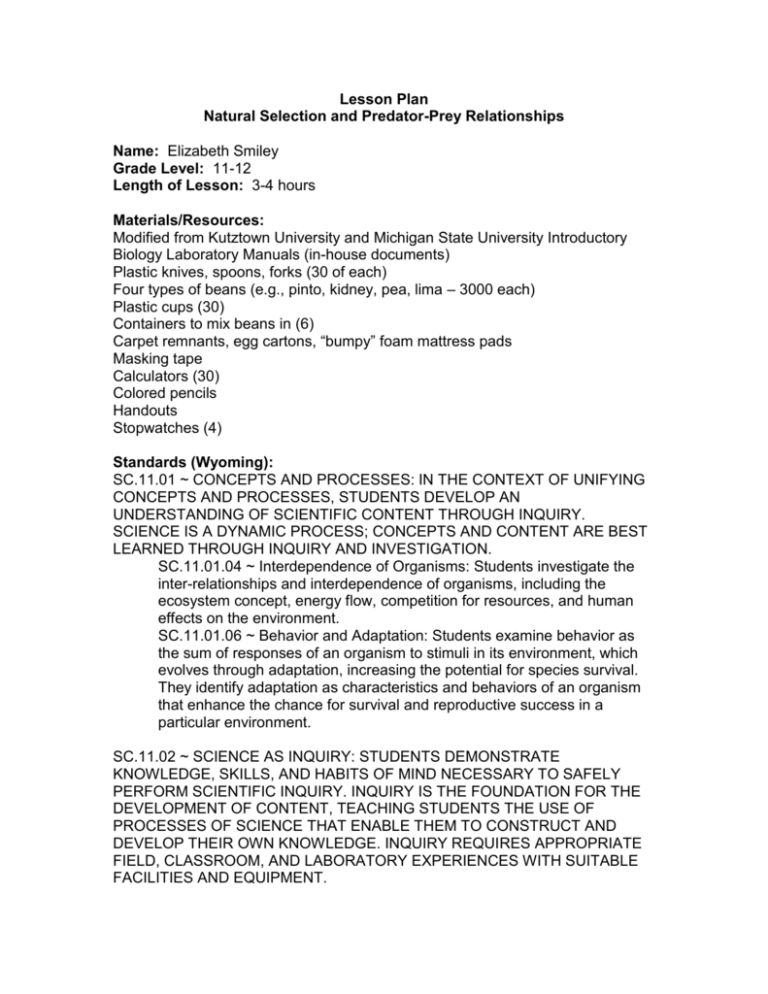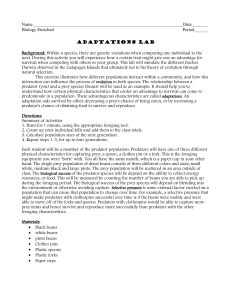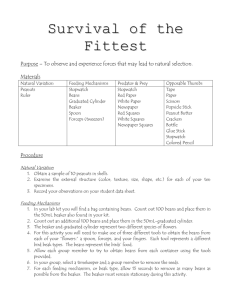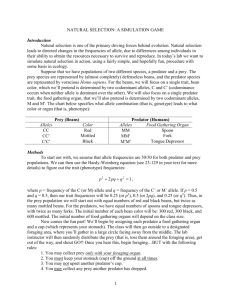LESSON PLAN FORMAT - University of Wyoming
advertisement

Lesson Plan Natural Selection and Predator-Prey Relationships Name: Elizabeth Smiley Grade Level: 11-12 Length of Lesson: 3-4 hours Materials/Resources: Modified from Kutztown University and Michigan State University Introductory Biology Laboratory Manuals (in-house documents) Plastic knives, spoons, forks (30 of each) Four types of beans (e.g., pinto, kidney, pea, lima – 3000 each) Plastic cups (30) Containers to mix beans in (6) Carpet remnants, egg cartons, “bumpy” foam mattress pads Masking tape Calculators (30) Colored pencils Handouts Stopwatches (4) Standards (Wyoming): SC.11.01 ~ CONCEPTS AND PROCESSES: IN THE CONTEXT OF UNIFYING CONCEPTS AND PROCESSES, STUDENTS DEVELOP AN UNDERSTANDING OF SCIENTIFIC CONTENT THROUGH INQUIRY. SCIENCE IS A DYNAMIC PROCESS; CONCEPTS AND CONTENT ARE BEST LEARNED THROUGH INQUIRY AND INVESTIGATION. SC.11.01.04 ~ Interdependence of Organisms: Students investigate the inter-relationships and interdependence of organisms, including the ecosystem concept, energy flow, competition for resources, and human effects on the environment. SC.11.01.06 ~ Behavior and Adaptation: Students examine behavior as the sum of responses of an organism to stimuli in its environment, which evolves through adaptation, increasing the potential for species survival. They identify adaptation as characteristics and behaviors of an organism that enhance the chance for survival and reproductive success in a particular environment. SC.11.02 ~ SCIENCE AS INQUIRY: STUDENTS DEMONSTRATE KNOWLEDGE, SKILLS, AND HABITS OF MIND NECESSARY TO SAFELY PERFORM SCIENTIFIC INQUIRY. INQUIRY IS THE FOUNDATION FOR THE DEVELOPMENT OF CONTENT, TEACHING STUDENTS THE USE OF PROCESSES OF SCIENCE THAT ENABLE THEM TO CONSTRUCT AND DEVELOP THEIR OWN KNOWLEDGE. INQUIRY REQUIRES APPROPRIATE FIELD, CLASSROOM, AND LABORATORY EXPERIENCES WITH SUITABLE FACILITIES AND EQUIPMENT. SC.11.02.01 ~ Students research scientific information and present findings through appropriate means. SC.11.02.02 ~ Students use inquiry to conduct scientific investigations. • Pose problems and identify questions and concepts to design and conduct an investigation. • Collect, organize, and analyze and appropriately represent data. • Give priority to evidence in drawing conclusions and making connections to scientific concepts. • Clearly and accurately communicate the result of the investigation. SC.11.02.03 ~ Students clearly and accurately communicate the result of their own work as well as information from other sources. MA.11.03 ~ MEASUREMENT: STUDENTS USE A VARIETY OF TOOLS AND TECHNIQUES OF MEASUREMENT IN A PROBLEM-SOLVING SITUATION. MA.11.03.03 Students identify and apply scale, ratios, and proportions in solving measurement problems. MA.11.05 ~ DATA ANALYSIS AND PROBABILITY: STUDENTS USE DATA ANALYSIS AND PROBABILITY TO ANALYZE GIVEN SITUATIONS AND THE RESULTS OF EXPERIMENTS. MA.11.05.04 ~ Students determine, collect, organize, and analyze relevant data needed to make conclusions. Objective: Students will simulate a predator-prey interaction using a hands-on activity, analyze data they collect, and interpret their results with respect to the role natural selection might play in living populations. I. Introductory Activity Show short video clip of cheetah hunting gazelle (or something similar). Students will list the ways each animal is adapted to survive (from both the predator’s and prey’s viewpoints). II. Explore the concept Ask students to list the three main components of natural selection and give some examples of predator-prey adaptations previously discussed in class. Ask students for other examples they might have thought of since our last discussion of the topic. III. Organize Concept – Connections Discuss how an understanding of natural selection and the coevolution of predators and prey might be useful. Real world applications might include: pesticides & insect resistance, use of biological controls in agriculture, invasive species, conservation or restoration of predator populations (like the black-footed ferret). How might science affect decisions made by ranchers, farmers, fish and game employees, politicians, and others? IV. Practice the Concept - Guided Practice with Feedback Discuss the use of mathematical and physical models in science. Have students look at “prey” (beans) types and “predator” (utensils) types and make predictions on which will survive better under different “habitat” (surface) types. V. Independent Practice Run simulation. Students will be the predators (utensils) and capture prey (beans) following a given set of rules. They will count the number of each type of prey caught by each type of predator. They will use proportional reasoning to calculate the number of predators and prey in the next generation. Repeat for 3 generations. Graph results and compare habitats. They will then answer a series of discussion questions looking at what it means to be “successful” from the prey and predator points of view. What traits led to their success (or lack thereof)? How does natural selection work (both in the simulation and real populations)? VI. What do students do if they finish early? Option 1: Think up alternative simulations you could run to test coevolution. Write a short paragraph outlining your plan. What would you test? How would you test it? What materials would you need? Option 2: Write a short paragraph discussing what you learned about natural selection and co-evolution of predator and prey populations. Discuss how this could be applied to wildlife management issues. VII. Conclusion Review key terms (natural selection, co-evolution, predator, prey, adaptation). Tie into upcoming lessons on the evolution of parasitism and mutualism. Assessment: Formative: Have students examine the data at different steps of the simulation and interpret or explain what is happening. Check the accuracy of the students’ calculations each generation before starting next step. Summative: Data is graphed in an appropriate manner (type of graph, labeling of axes, accuracy). Interpret data and answer discussion questions provided to assess understanding of natural selection and co-evolution. Optional exercises: Write short answer essay on topic given. Paragraph must address topic, be clear and concise, and grammatically correct. Accommodations: Make sure all students know how to use calculators and proportional reasoning to estimate future population sizes. Peer tutoring for those students who have trouble with mathematics. Extra time to complete assignment. Report results pictorially or verbally. Reflection: Count beans out in units of 100 ahead of time and store in small baggies until needed (the students take a very long time to count out beans). Write some sample math problems and have the students practice using calculators. Twothirds of the class had trouble entering the numbers and operators in correctly. Also, review how to make a line graph and what types of graphs are most appropriate with this type of data. Collect old datasets and have them available so that they can compare their information to other classes. Maybe set up collaboration with other schools so they can compare their data to other schools. The lesson is worth doing, but need to streamline some parts of it to speed it up so students have more time for interpreting data and discussion. In an ideal situation, we would have a variety of materials at hand so students could design their own experiments. However, due to time constraints and class sizes this may not be practical.











